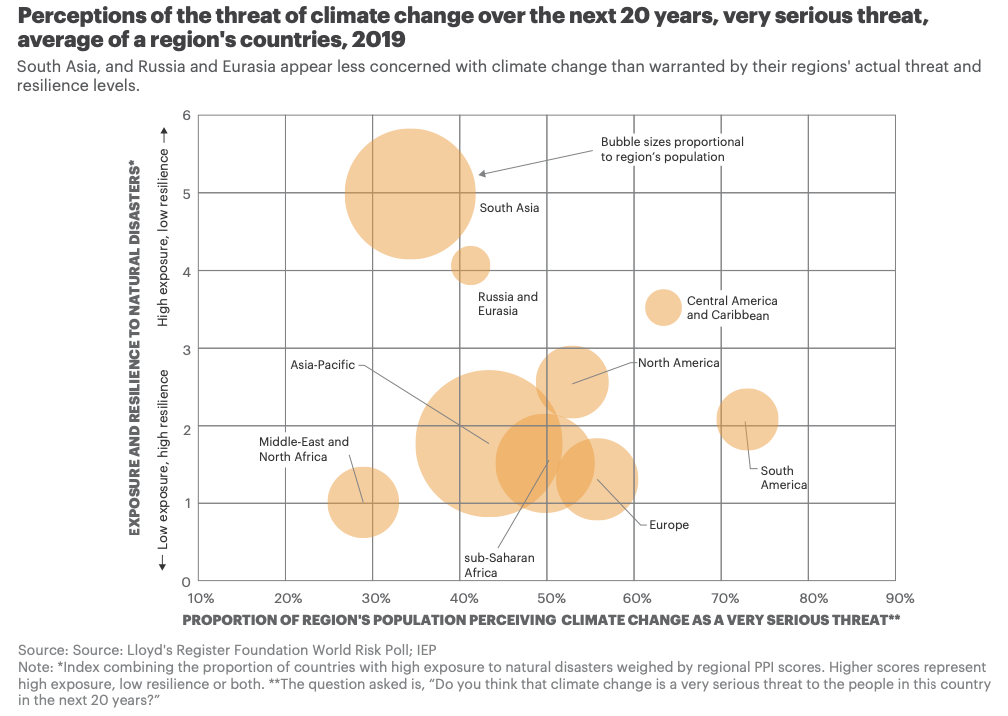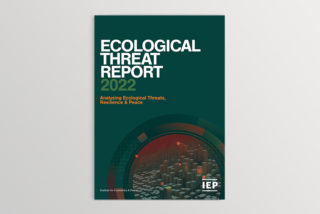The new report on regional climate change perceptions reveals that of the most significant emitters of carbon dioxide are countries where their citizens are least concerned with climate change as a very serious threat.
The analysis was enabled by data from the Lloyds Foundation World Risk Poll, the first global study of worry and risk ever mounted at this scale. Conducted by Gallup as part of its World Poll, it’s based on interviews with over 150,000 people in 142 countries, including places where little or no official data exists.
Of the 142 countries covered in the survey 68 countries, or 48%, had more than 50% of people think that climate change posed a very serious threat to the country in the next 20 years, while eight countries recorded 75% or greater.
None of the four greatest carbon emitting countries in the world, China, United States, India and Russia, had more than 50% of respondents saying climate change was a very serious threat to their country in the next two decades.
Amongst the fifteen greatest emitters per capita were the Middle Eastern countries Oman, UAE, Bahrain, Kuwait and the largest carbon emitter per capita, Qatar. UAE, Bahrain and Kuwait had 26.4%, 32% and 35.1% respectively of respondents saying that climate change posed a very serious threat to their country in the next two decades. This was a relatively low level of concern. Oman and Qatar were not included in the Lloyd’s Foundation World Risk Poll.
There were three countries that ranked in both the top fifteen of raw carbon emissions as well as per capita emissions, namely Canada, United States and Australia. The percentage of respondents in those countries that saw climate change as a very serious threat was 56.4%, 49.2% and 52.2% respectively, putting all of those countries mid-table in respect to climate change concern.
The most populated country in the world, China, has a very low level of concern, with only 23.3% or respondents saying they thought climate changed poses a very serious threat to the people in their country in the next two decades. This is one of the lowest results of all the countries polled. This was largely in line with Chinese responses when asked about environmental risk, industrial risk and nuclear risk, which was generally low. Chinese women showed a lower level of concern about climate change than Chinese men.
Of the 142 countries polled, only six countries ranked lower than China in climate change concern. These countries included Ethiopia, the second most populous country in Africa, and Saudi Arabia, one of the fifteen most significant carbon emitters per capita in the world.

Asia Pacific
Three of the ten countries showing the least level of climate change concern were from the Asia Pacific region, namely Myanmar, who was the fourth least concerned country, China the seventh least concerned and Cambodia, tenth. Also in the bottom 25 was Laos at 12 and Indonesia at 22.
Singapore had the highest level of concern out of all the Asian Pacific counties, with 72.9% of respondents saying that climate change will pose a very serious threat in the next two decades. There were only ten other countries with a higher level of concern overall. The next most concerned Asian Pacific country was Vietnam, at 61.8% and then Taiwan at 59.8%.
Of all the global cohorts recorded, men from Myanmar showed the second lowest level of concern, at 18.5%.
Central America and the Caribbean
People from Central America and the Caribbean generally showed a high level of concern about climate change, with all nine countries in the region having more than 50% of respondents saying they saw climate change as a very serious threat.
Costa Rica had the highest level of concern of all countries in the region, with 81.8% of respondents saying they saw climate change as a very serious threat. Only four countries showed a higher level of concern globally, and Costa Rican men showed the second highest level of concern of any global male cohort, after Chilean men.
The second highest level of concern overall in Central America or the Caribbean was shown by Mexico, with 70.1% of respondents saying they saw climate change as a very serious threat. Of countries in the region, Nicaragua showed the lowest level of concern, at 52%.
Europe
Of the 36 countries in Europe, 23 scored better than the global national average of 50% of respondents who saw climate change as a very serious threat.
Four of the ten most concerned countries globally were European. These four countries were two pairs of countries with geographical and social proximity. These couplings were Spain and Portugal, who were second and third overall, and Greece and Cyprus, who were fourth and seventh.
The Scandinavian countries showed some of the lowest level of concern in Europe, with Sweden, Norway, Denmark and Finland being four of the six European countries reporting least concern. The other two counties are former Soviet Republics Estonia and Lithuania, which are in close geographical proximity to Scandinavia.
Generally European women showed a higher level of concern about climate change than men, and Spanish women exhibited the highest level of concern about climate change of any cohort recorded, with 87.4% of respondents saying they think that climate change will pose a very serious threat in the next two decades. Almost ten percent fewer Spanish men responded similarly. The greatest gender disparity was in the Scandinavian countries of Norway, Sweden and Finland where women scored higher than men by the 21%, 18% and 13% respectively.
Middle East and North Africa
The lowest level of concern of any region in the world was exhibited in the Middle East and North Africa. Of the twenty countries least concerned with climate change, ten were from MENA, namely Yemen, with only 12.7 per cent of respondents saying they saw climate change as a very serious threat.
Egypt recorded 17.6%, followed by Saudi Arabia and Libya at 22.3% and 24.4% respectively. Morocco expressed the highest level of concern in the region, but at 46.3% this still puts the nation in the bottom half of most concerned counties.
With some exceptions, men from MENA were generally more concerned about climate change than women and, of all global cohorts, Yemeni women were the least concerned about climate change, with only 9.5% saying they were very concerned about climate change. The second least concerned cohort was Egyptian men, at 16.3%.
North America
Canada has a higher level of concern about climate change than its regional partner United States of America, with 56.4% and 49.2% respectively saying climate change will pose a very serious threat to their country in the next twenty years. Both countries placed in the middle on the global rankings in regards to climate change perceptions.
Both Canadian women and women from the United States showed a higher level of concern than their male counterparts.
Russia and Eurasia
Most countries in Russia and Eurasia were mid-ranking when gauging climate change concern, except for four countries in close geographical proximity, who showed relatively low concern.
The country with the lowest level of concern in the region was Uzbekistan, where only 22.4% of respondents said climate change posed a very serious threat, followed by Azerbaijan, Turkmenistan and Armenia at 31.4%, 33.1% and 37.2% respectively. The highest level of concern in Russia and Eurasia was shown by Georgia, where 56.9% of respondents said climate change was a very serious threat.
South America
Of all of the world’s regions, South America expressed the highest level of concern about climate change. All of the region’s eleven countries were in the top twenty countries most concerned about climate change, except for Venezuela, which was the 28th.
Chile was the country reporting the most concern in the region, and was also the most concerned country of all the 142 nations polled, with 87.3% respondents saying they thought climate change was a very serious threat. Chilean men were the most concerned of all the male cohorts, with Chilean women second only to Spanish women in their level of climate change concern.
South Asia
Countries in South Asia uniformly showed a low level of climate change concern, with each of the six countries in the region ranking in the bottom third of global concern.
Sri Lanka expressed the highest level of concern, with 39% of respondents saying climate change was a very serious threat. The lowest level of concern in the region was from Bangladesh, at 28.7%.
Of all South Asian cohorts, Afghan men showed the highest level of concern, with 46.7% of respondents saying climate change posed a very serious threat. This is in great contrast to the responses of Afghan women, at 28.2%.
Sub-Saharan Africa
Sub-Saharan African countries showed little regional coherence, with the 34 countries from the region spread across the response range.
The country from SSA with the highest level of concern was Lesotho, with 77.9% of respondents seeing climate change a very serious threat. Just below Lesotho was Malawi with 74.6%. This placed them as the sixth and ninth most concerned countries respectively in terms of climate change perceptions globally.
On the other end of the table Ethiopia, at 17.5%, was the country least concerned about climate change in the region, and showed the second lowest level of concern of the 142 countries polled, after Yemen.
Generally, SSA countries had a middling level of concern, with 23 of the 34 counties in the region reporting between 40% and 60% of respondents saying that climate change was a very serious threat.
Download the full report – Changing Perceptions in a Changing Climate
